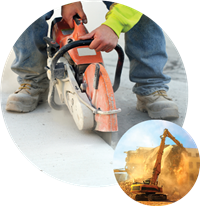
Home / Services / Industrial Hygiene / Exposure Testing and Monitoring for Toxics and Other Hazards / Respirable Crystalline Silica
Respirable Crystalline Silica
Exposure to respirable crystalline silica can lead to life-threatening conditions such as lung cancer, silicosis, immune system effects, and kidney effects. Over 300 workers die in the U.S. every year from silicosis, but it is often misdiagnosed because the symptoms resemble other diseases: shortness of breath, chest pain, persistent dry cough, loss of appetite and weight loss, extreme fatigue, fever, and bluish tint on nails. As established under California Code of Regulations (CCR) Title 8, Section 5204 for general industry and Section 1532.3 for the construction industry, employers must evaluate and control occupational exposures to silica to ensure that their employees are properly protected.
Yorke Services
Yorke Engineering stands as an expert in Industrial Hygiene and Safety, offering invaluable assistance in navigating the latest respirable crystalline silica emergency temporary standard. We are here to assist you with conducting air monitoring of employees and developing a written Exposure Control Plan and Respiratory Protection Program tailored to your organizational needs. We can also assist with interpreting the latest regulatory requirements effectively for your specific work site, ensuring optimal compliance and safety measures.
Yorke can assist with the silica requirements as detailed below:
- Employee silica exposure monitoring/testing;
- Written Control Plan development;
- Response to California Division of Occupational Safety and Health (Cal/OSHA) silica investigations; and
- Respiratory Protection Program development.
Emergency Temporary Standard for Respirable Crystalline Silica
As of December 29, 2023, revisions to the respirable crystalline silica standard [California Code of Regulations (CCR) Title 8 Section 5204] for occupational exposures to silica are in effect. This is a temporary revision while permanent revisions are still in development, and it applies to all occupational exposures except construction work, agricultural operations, and exposures from the processing of sorptive clays. It affects workplaces that manufacture artificial and natural stone products that contain more than 10% silica. (Artificial stone is any reconstituted, artificial, synthetic, composite, engineered, or manufactured stone, porcelain, or quartz typically within a binding material. It contains more than 90% crystalline silica).
The requirements of the Cal/OSHA emergency temporary standard include:
- Implementing effective dust suppression by ensuring water covers the entire surface where a tool or machine contacts a work object. This can be achieved by:
- Applying continuous, appropriate volumes of water;
- Submersing the work object under water; or
- Utilizing water jet cutting.
- Establishing a regulated area identified by warning signs. The signage must be written in both English and Spanish.
- Protecting workers from airborne exposures during housekeeping and maintenance work by:
- Cleaning up debris to prevent dust buildup;
- Cleaning only using wet methods or high-efficiency particulate air (HEPA) filter vacuums;
- Prohibiting dry sweeping or use of compressed air to clean off surfaces or clothing;
- Prohibiting employee rotation to reduce employee exposures to silica; and
- Prohibiting walking or moving equipment through dry dust.
- Developing a written Exposure Control Plan.
- Communicating with and training employees.
- Providing respiratory protection and preparing a written Respiratory Protection Program. Respiratory protection is mandatory for all employees and includes:
- A full-face, tight-fitting powered air purifying respirator (PAPR) or a respirator providing equal or greater protection equipped with a high-efficiency particulate air (HEPA), N100, R100, or P100 filter;
- Combination organic vapor cartridges must also be used for artificial stone unless the employer demonstrates that employee exposures to any organic compounds known to be present in the artificial stone are not above the corresponding permissible exposure levels (PELs) established in 8 CCR Section 5155;
- A loose-fitting PAPR, a non-powered full-facepiece air purifying respirator, or an equally protective alternative, such as a half-face PAPR, may be permitted if the employer demonstrates exposures are below the action level (AL) through air monitoring every 6 months, unless a health care professional recommends greater protection; and
- Respirators must be used in accordance with an effectively implemented Respiratory Protection Program that meets the requirements of 8 CCR Section 5144.
- Conducting employee exposure monitoring at least once every 12 months.
- Reporting any confirmed respirable crystalline silica exposure-related silicosis and cancer cases to Cal/OSHA and the California Department of Public Health within 24 hours.
